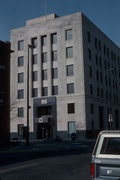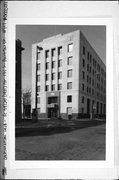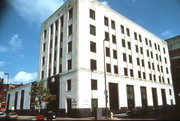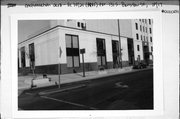Property Record
131 S BARSTOW ST
Architecture and History Inventory
| Historic Name: | UNION NATIONAL BANK, First Wisconsin National Bank |
|---|---|
| Other Name: | U.S. Bank |
| Contributing: | |
| Reference Number: | 291 |
| Location (Address): | 131 S BARSTOW ST |
|---|---|
| County: | Eau Claire |
| City: | Eau Claire |
| Township/Village: | |
| Unincorporated Community: | |
| Town: | |
| Range: | |
| Direction: | |
| Section: | |
| Quarter Section: | |
| Quarter/Quarter Section: |
| Year Built: | 1930 |
|---|---|
| Additions: | 1980 |
| Survey Date: | 1981 |
| Historic Use: | bank/financial institution |
| Architectural Style: | Art Deco |
| Structural System: | |
| Wall Material: | Limestone |
| Architect: | Burnham Brothers, Inc, Chicago |
| Other Buildings On Site: | |
| Demolished?: | No |
| Demolished Date: |
| National/State Register Listing Name: | First Wisconsin National Bank |
|---|---|
| National Register Listing Date: | 1/28/1983 |
| State Register Listing Date: | 1/1/1989 |
| National Register Multiple Property Name: | Multiple Resources of Eau Claire |
| Additional Information: | A vertically oriented and relatively unadorned building, the First Wisconsin National Bank is a six story rectangular monolith constructed of smooth white Alabama limestone accented at the ground level by dark polished granite. The main facade which faces S. Barstow Street, Eau Claire's major business avenue, is characterized by a two story rectilinear portal framed with the granite that covers the lower portion of the building's ground story. Four rectangular windows - those on the first floor are identified by panels containing geometrically designed floral patterns - flank the prominent entry which is highlighted by a carved panel featuring an eagle. The first two stories of the bank building are differentiated from the upper four stories by the entrance area and by horizontal scoring that continues around the south facade of the bank, where two story openings, which light the bank lobby, punctuate the lower wall surface. Above the scoring on the main facade, each of the floors is marked by five windows. (Note: All of the bank's windows are modern single light plates). The outside openings are paralleled by vertical bands of fluting which terminate above the sixth story with large square panels of floral and geometric design. Until 1980 the building's name was included in the area between the panels. The three inner windows are recessed and separated horizontally by wall surfaces bordered by a "zig-zag" design. A similar fenestration and fluting pattern is evident on the south facade. Once again the outer openings are identified with fluting and carved panels. Between them are five pairs of windows, each pair framed by fluting. The "zig-zag" pattern is also repeated below each window. Extending north of the main block is a two story bank addition erected in 1980. The architecturally compatible addition features similar construction materials and maintains the design of the original structure. Also in 1980 the interior of the bank building was remodeled. Attached at the rear of the bank is a portion of a city parking ramp, an addition not considered significant to the nomination. Located in Eau Claire's central business district and designed by Burnham Brothers, Inc., Chicago architects, the First Wisconsin National Bank is the city's primary example of Art Deco/Moderne architecture. Although a simplified and unpretentious amalgam of the two styles, the bank building represents within the community a vestige of the "modern" architecture that highlighted the nation's larger cities. The bank structure, described at the time of its construction as "a most imposing and stately strcuture, standing out in plain, but impressive beauty for its full height of six stories," (A) is also one of the last remaining intact commercial structures in Eau Claire and as such makes a vital contribution to the city's cultural landscape. The Union National Bank was organized in 1906 through the merger of two local banks, the Bank of Eau Claire and the Chippewa Valley Bank. The Bank of Eau Claire, the older of the two original institutions, was established in the early 1870s as the First National Bank of Eau Claire. In 1878 the bank was reorganized as the Bank of Eau Claire with F.W. Woodward as president; William A. Rust, vice-president; and George T. Thompson, cashier (B,C). The Chippewa Valley Bank, the successor of the private banking firm of H.C. Putnam Company, was founded in 1885. H.C. Putnam, one of Eau Claire's most prominent citizens and businessmen, was the bank's first president and George Thompson its cashier (B). The Chippewa Valley Bank Building (the preferred name is the Barnes Block) is listed in the National Register (1982). The first officers of the Union National Bank were William P. Bartlett, president; James T. Joyce, vice president; George T. Thompson, cashier; and Marshall Cousins, assistant cashier. In 1911 William Bartlett was succeeded as president by O.H. Ingram, a prosperous lumberman (B). Later in the twentieth century (1929) First Wisconsin Bankshares Corporation obtained an interest in the bank (D). This additional backing enabled the Union National to survive the depression, the only financial institution in Eau Claire to do so. In 1965 the bank's name was changed to First Wisconsin National Bank, to Firstar Bank in 1994 and to U.S. Bank in 2002. 2016- "This building was the city's primary example of Art Deco architecture and is the only major surviving building of its style. It represents the "modern" architecture that highlighted the central business districts of the nation's largest cities in the nineteen-twenties and thirties. The building was desgned by Burham Brothers, Inc., of Chicago. An architecturally compatible two-story addition was erected north of the main building in 1980. The Union National Bank was organized in 1906 through the merger of two local banks, the Bank of Eau Claire (established in the early 1870s) and the Chippewa Valley Bank (founded in 1885). In 1929, First Wisconsin Bankshares obtained an interest in the bank. This additional backing enabled the Union National to survive the Great Depression, the only one of four banks in Eau Claire to do so. The name of the bank was changed to First Wisconsin National Bank of Eau Claire in 1965, to Firstar Bank in 1994 and to U.S. Bank in 2002." -"Eau Claire Landmarks: Designated Historic Properties in Eau Claire, Wisconsin", Eau Claire Landmarks Commission, P.O. Box 5148, 2016. |
|---|---|
| Bibliographic References: | (A) EAU CLAIRE LEADER, 12/14/30, P. 5. (B) HISTORY OF EAU CLAIRE CO, 1914, PP.536-538 (C) EAU CLAIRE LEADER, 12/14/30, P. 4. (D) EAU CLAIRE:THE SAWDUST CITY, 1972, P. 89. Take a Walk on Main Street: Historic Walking Tours in Wisconsin's Main Street Communities, Wisconsin Main Street Program, 1998. Eau Claire Landmarks booklet published by the Landmarks Commission in 2002. |
| Wisconsin Architecture and History Inventory, State Historic Preservation Office, Wisconsin Historical Society, Madison, Wisconsin |





